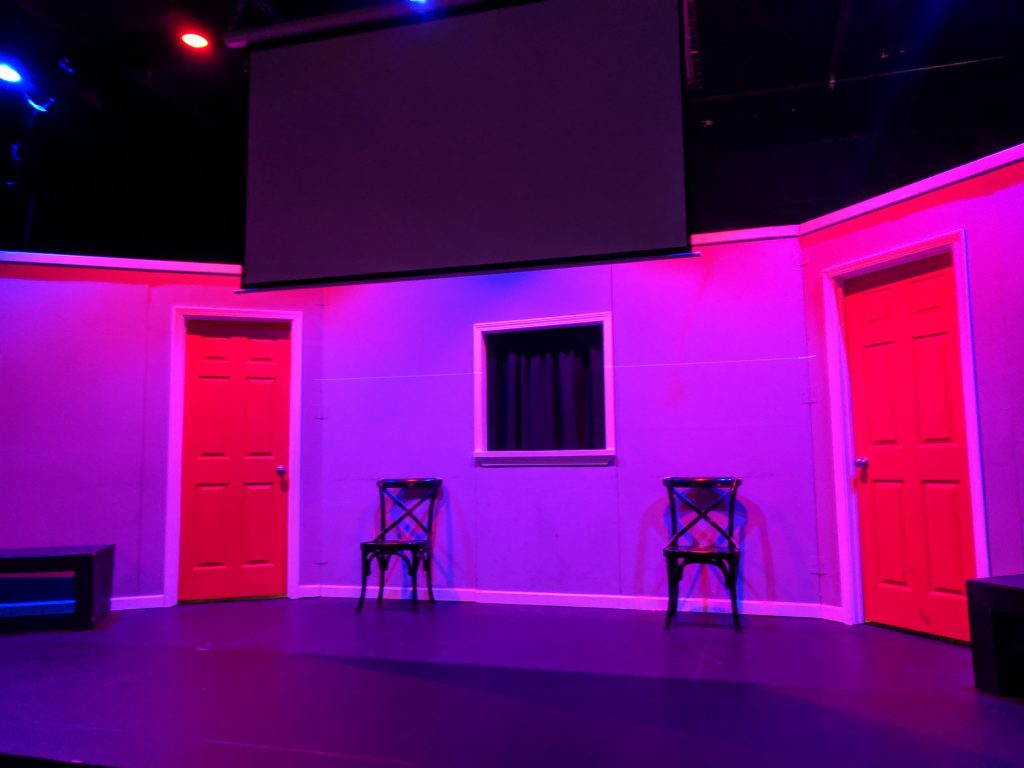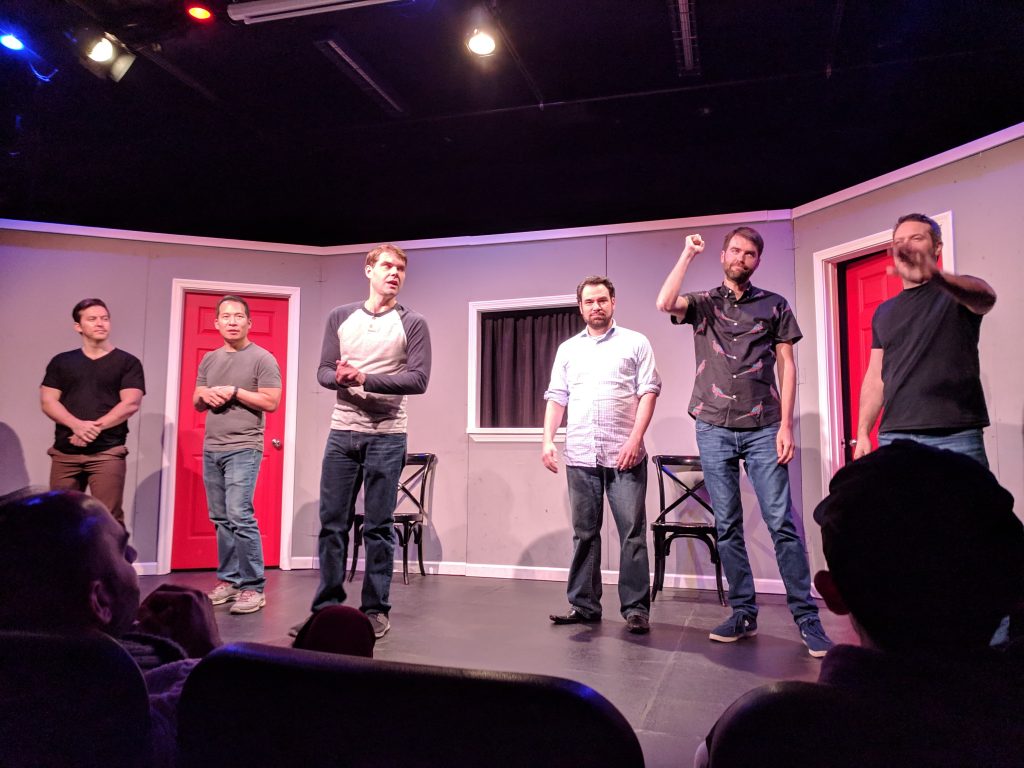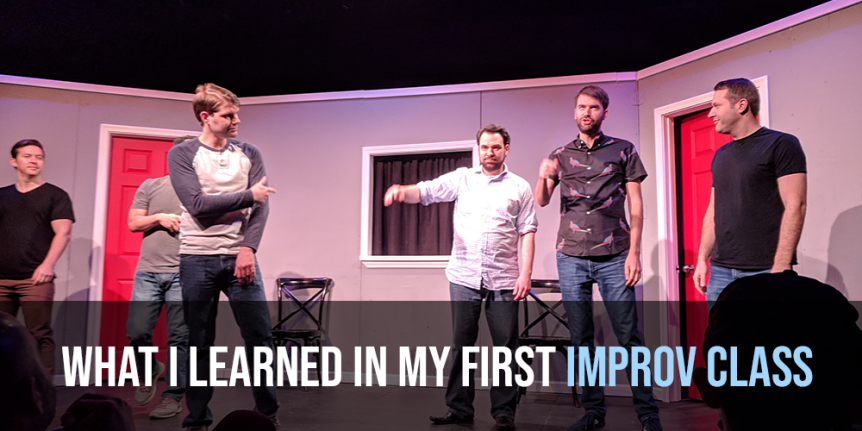I have this fear of public speaking (and the stage in general). And sometimes I even get nervous when I have to speak with acquaintances one-on-one. I think I do okay, but knowing I have to occasionally fill conversation gaps, think on the spot, and maintain small talk can worry me. It might sound silly to you, but it’s a bigger deal for an introverted, shy girl like me!
I’ve been spending a lot of this past year doing challenges and working on self improvement. I decided to take some action steps towards my above fears…
And I decided to sign up for improv class.
DUN. DUN. DUN.
For someone like me, this seemed like the scariest thing ever. Since I bought the class package a few months ago, I decided not to think about it until March came around. Now that we’re in the month of March, I lightly panicked on the day of my first class. It dawned on me what this would entail – being witty, performing in front of people, hoping the stuff I say isn’t stupid, etc.

And I remembered my experience at Toastmasters and how I ended up stressed the entire meeting. (I still plan to complete a few months of Toastmasters, but I chose improv as a first step). I was scared I would get to improv class and end up dreading it each week. Since I paid for 8 weeks of classes, I knew there was no backing out.
But surprisingly, my first improv class ended up being a blast. It was the perfect class, and I am pretty excited for my next one.
Why?
In this blog post I want to talk about how my first improv experience went, what I’ve already learned so far, and why it’s keeping me excited and ready for the next class.
If you have similar fears or characteristics you want to improve on, perhaps this post will inspire you to join me in this new endeavor.
What I Learned in My First Improv Class
1. Messing up isn’t that big of a deal
When I arrived (slightly late) to Made Up Theatre, the class had already formed a circle on stage ready to begin their first exercise. Most of the beginning exercises warmed us up to think quicker and on our feet. We started with an easy exercise where we would point, make eye contact with someone, and say “Zip”. The next person would say “Zap”, and the person after would say “Zop”, and it would continue this way in a loop. We would try to do this exercise as fast as possible.
From the very first game, the instructor mentioned that anytime anyone made a mistake, everyone had to link arms and yell “Awooga!” and kick out their feet. He mentioned not to worry about messing up as we all mess up. And doing this “awooga” exercise made us feel more like a team and made mishaps less critical. As we proceeded to do this I started laughing and feeling like a kid again. The crap we were doing just felt so silly! We started embracing mistakes and enjoying the community feel and playfulness that came along with it. We learned that mess ups aren’t that embarrassing or that big of a deal, and that most people are actually focused on their own actions and not you.

2. With playfulness and laughter comes presence
At one point I realized that my phone had been in my bag for a long time, and I hadn’t been thinking about it. I was present the entire class, laughing and having fun, acting a fool, not thinking about anything else (which is very rare and difficult for me). Even when improv requires you to be on your toes, it was almost relaxing in a way because I stopped thinking about anything else. And that’s when you know you’re experiencing “flow” and actually enjoying the process. I wasn’t working on getting to some next level goal. I was just having fun. I know that improv is going to get a LOT harder later, especially as this was the first class. So hopefully it doesn’t go downhill from here as I’ve been having a great time!
3. The power of “Yes, and”, and the team feeling it forms
You’ll probably hear this a lot in improv. It’s apparently a main theme, that when someone presents a new idea, you run with it and say “Yes, and” because it’s easier to build a scene that way.
To illustrate this, the new exercise required us to partner up and plan a party together with back and forth suggestions. However instead of going with each idea, we would say “no” to every suggestion the other person said, and provide another suggestion. After many rounds of this, we switched to “yes, but”.
When we rejected each other’s ideas with “no”, we had to start from scratch with a whole new idea. When we responded with “yes, but”, it was a bit easier but it still wasn’t exactly a team effort. We were basically saying “I hear you, but this other thing might be better”. You’re sort of listening but you’re not really listening.
And finally we used “Yes, and”. By doing this, we noticed that it was much easier to work off each other because we already had a base idea to work off of. We were making progress in a forward direction rather than dismissing people’s ideas.
The instructor didn’t mention this as much, but I feel like the team aspect is a huge benefit of “Yes, and”. You’re building a camaraderie with people and you’re having each other’s backs. You’re basically supporting people with whatever idea they give so everyone feels included, encouraged, and not alone. This boosts morale. And it makes people less scared of making a “wrong choice” – because there IS no wrong choice!
Here’s a great video to illustrate this point. “Improvisation is like the military, you leave no man behind” (2:26), says Amy Poehler:
I think the points she makes in the video can really be applied in life. When you support another person and have their back, encourage their ideas, it can really make a difference in their lives. And when you turn to another person and they’re not there for you, you’ll remember that forever as well.
4. Communication
We did a few more exercises to illustrate effective communication and quick teamwork.
For one exercise, we partnered up and were given 5 seconds to use our bodies to act like a knife and a fork, a vase and a flower, and a knight and a horse. I called out to my partner “I’ll be the flower” and spread my arms out like they were petals. The other person quickly realized he had to be a vase and kneeled down and linked his arms around my knees. Then we combined with another group of 2, so we became a group of 4 working the same exercise. Afterwards we did 10 people, and then the entire 20-person group.
What we learned was that usually there are leaders who call out what they’re going to be. This allows other people to build off that idea and figure out what other parts are necessary for what they need to re-enact. The quick and effective communication requires saying things out loud and having some leaders and followers.
5. Unison
In another game, there were 3 different gestures that corresponded to a Tiger, Martian, or Salesman. We formed groups of 3, and we faced each other back to back. The goal was to turn around and have all 3 of us performing the same action. Ultimately the idea was that after a bunch of tries, you’ll start sticking to a routine pattern and figure out what the group is trying to do. And that’s the idea of improv, you’re all working towards one direction and you’re trying to stay in unison.
We did a few more exercises that illustrated the unison concept:
- We partnered up. My partner would lead with slow movements, and I would copy and add to it. He would then follow and start adding again, and we would try to get our motions in sync where we didn’t know who was leading and who was following.
- One person in the entire 20-person group started leading the actions of the group, and the person who didn’t know who the leader was had to identify the leader.

6. Give and Take
“Give and take” was one of the hardest exercises for me (and the instructor mentioned that it is one of the harder improv concepts as well). In the exercise, 20 of us spread out around the room. One person took the spotlight and walked around, while nobody else was moving in the class. That person would pass that spotlight to someone else in the room without any strong cues like “your turn”. They would just send it through action. This was easy enough, but when we expanded to monologues it got a LOT harder. I was not ready for it to be passed to me!
The “Give” idea was similar, except someone would TAKE the spotlight from the person. “Taking” is not done in a hurtful way. Instead it is to save people especially when they’re losing steam.
Something I noticed was that with dance and physical movement, I had an easy time. It was my strong suit as I love freestyling on the dance floor! But when it came to actually speaking, I struggled. I didn’t want to volunteer myself and I tried to avoid the spotlight. When I actually attempted to take the spotlight, my mind went hazy and I ran out of steam within the first few seconds. This is something I will need to get better at and fill my head with more confidence. I think if I challenged myself to constantly speak on-the-spot, I will start feeling like it is a strength of mine, not a weakness. And the more confidence I have in it, the more I’ll release that nervous, hazy feeling in my head so I can perform better.
Other Exercises We Did…
We practiced so many different exercises. Here were two more that we tried out, and they were super fun!
- We were in a circle. 3 people entered the middle of the circle and pretended to be objects that fit a scenario. 2 of the 3 people would leave and 2 new people would come in to create a new scenario. This was repeated over and over again.
- We were in a circle. 3 people entered the middle of the circle and created random shapes with their bodies. Someone in the outside circle titled what the shapes formed. Then that person went into the circle, and 2 new people went in to form a shape together, waiting for their shapes to be named.
Conclusion
I have a new admiration and appreciation for improv! Alongside performers in musicals, improv actors have now gained my newfound respect. The only thing I knew about improv in the past was the show “Whose Line is it Anyway” (I’m sure you’ve watched it before).
Now I’ve started immersing myself in more improv videos. I’ve also watched improv live for the first time!
I have so much respect for this art because it’s something I feel incapable of doing based on my skills. The teamwork aspect of improv gives me good feels as well! Though I currently feel this lack of skill, I am working towards getting better and hope to build confidence in on-the-spot thinking and public speaking.



Comments 2
Love this. This and your Toastmasters post are my favorites because I know they are hard for you, but you’re embracing uncomfortableness. Most of us try to avoid it. And it’s interesting how different we are in that I would be much more comfortable with my words and very uncomfortable with movements, and you are the opposite. Can’t wait to hear more about both improv and Toastmasters.
Author
Thanks so much! Haha I am learning to be okay with messing up, and it’s great. I still get really nervous but I try to force myself to volunteer now, and I think it’s helping with my confidence. I’m halfway through classes now – we shall see how it continues!